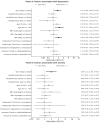Effects of Sex and Race on Epidemiology and Comorbidities of Patients with Irritable Bowel Syndrome: A Rome III Era Retrospective Study
- PMID: 40422593
- PMCID: PMC12110308
- DOI: 10.3390/diseases13050161
Effects of Sex and Race on Epidemiology and Comorbidities of Patients with Irritable Bowel Syndrome: A Rome III Era Retrospective Study
Abstract
Background: Irritable bowel syndrome (IBS) is a prevalent disorder of gut-brain interaction (DGBI) with a negative impact on quality of life and healthcare expenditure. This study aimed to investigate sex-based differences in a large cohort of IBS patients from a multiracial safety-net hospital.
Methods: An electronic query was performed using the International Classification of Diseases, 9th Revision (ICD-9) coding to identify 740 outpatients with IBS between 1 January 2005 and 30 September 2007. Demographic data and ICD-9 coded comorbidities were extracted from electronic records. Data analysis used descriptive statistics and multiple logistic regression analyses.
Results: Comorbid anxiety and depression were significantly more prevalent in female patients (A:24%, p = 0.03; D:29%, p = 0.008) compared with male patients. White female IBS patients had a higher risk for anxiety but not depression compared with non-White patients (p = 0.02). Female sex (p = 0.02), obesity (p = 0.007), and age above fifty (p = 0.02) but not race/ethnicity were significant risk factors for depression. IBS with constipation was more prevalent in female patients (p = 0.005) and in Hispanic compared with non-Hispanic patients (p = 0.03).
Conclusions: Significant sex-based and racial/ethnic differences were identified related to body mass index (BMI), age, and IBS subtypes in this study. Comorbid mood disorders occurred significantly more frequently in female patients, and risk factors for comorbid depression included female sex, older age, and obesity but not race/ethnicity.
Keywords: anxiety; comorbidities; depression; eating disorders; irritable bowel syndrome; racial differences; sex.
Conflict of interest statement
The authors declare no conflicts of interest.
Figures


References
LinkOut - more resources
Full Text Sources

